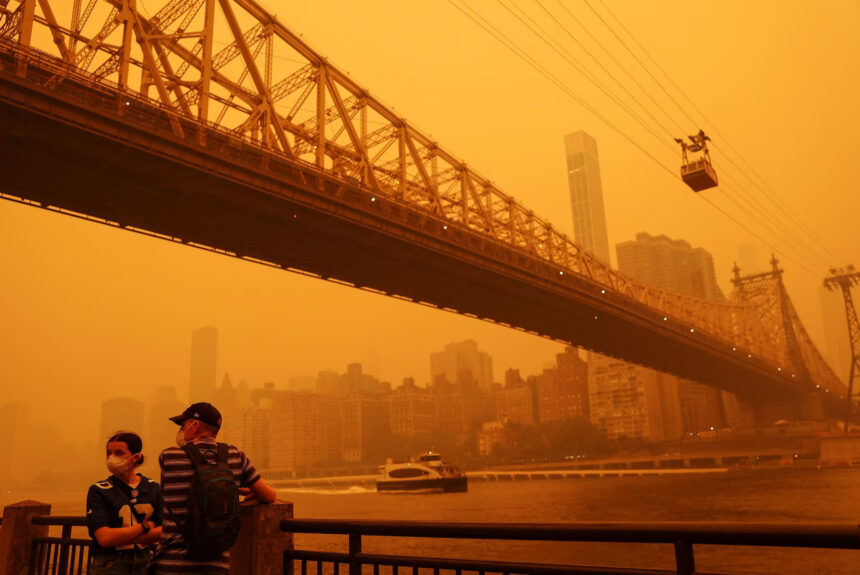On Wednesday morning, Northeastern residents woke up to a scene from Blade Runner as smoke and haze from Canadian wildfires drifted to the United States. The wildfires, which continue to burn, have displaced thousands of families and burned 9.4 million acres, an area larger than Connecticut and nearly 15 times higher than Canada’s ten-year average. For many residents of the western states and territories, the effects of devastating wildfires are all too common. For those on the East Coast, Canada’s devastating fires are a wake-up call to address and reduce wildfire risk through active forest management and smart policy reform.
>>>READ: Without Reforms to the Environmental Review Process, Wildfires Will Grow Worse
Some policymakers and government officials have been quick to call the northeast’s experience with poor air quality as another data point that the climate crisis is here and now. While it is true that human-driven warming is making parts of the world hotter and drier and thereby lengthening fire seasons, it is not the sole reason for why wildfires are becoming more destructive. The inability to actively manage forests through prescribed burns and timber development, more people moving to the wildland-urban interface, and subsidized insurance policies that distort the risk of living in these areas all have a role to play.
Canada’s wildfires should drive more geographical buy-in for the policy reforms needed to reduce wildfire risk and costs in the U.S. One of the most immediate actions that needs to be taken is addressing forest management backlogs on federal lands. According to the Forest Service’s own estimate, 80 million acres of land are in need of restoration and 63 million acres face severe or very severe wildfire risk. The Biden administration’s pledge to address a backlog of 4 million acres will fall well short of what is needed to meaningfully wildfire reduce risk. To see more effective forest management, policymakers need to modernize outdated laws like the National Environmental Policy Act (NEPA).
NEPA’s inefficiencies delay the completion of active forest management projects on federal lands. As the Property and Environment Research Center (PERC) noted in a 2022 policy brief, “Once the Forest Service initiates the environmental review process, it takes an average of 3.6 years to begin a mechanical treatment and 4.7 years to begin a prescribed burn. For projects that require environmental impact statements—the most rigorous form of review—the time from initiation to implementation averages 5.3 years for mechanical treatments and 7.2 years for prescribed burns.”
Even after an agency has received the necessary permits to begin, activists can hold up the project in court for years. Completing these forest management projects can make a significant difference in reducing wildfire damage and also makes forests more resilient to drought, high temperatures, and invasive species.
>>>READ: Why are Wildfires Getting Worse? Regulations Are Partly to Blame
Other problems, including a lack of sufficient funding and a federal strategy that allocates resources to fighting wildfires instead of preventing them, also make wildfires worse. Private companies, local entities, and private property owners are stepping up to address these challenges. Blue Forest Conservation, a non-profit that connects companies and private investors with conservation groups and property owners, recently announced that it had raised $50 million to finance forest restoration projects in high-risk areas in California, Oregon, and Washington.
In addition, policymakers should scale up public-private partnerships by empowering the Forest Service to enter into longer-term contracts and cooperative agreements. The success of a pilot project in Washington’s Colville National Forest could serve as a model for future endeavors.
Private markets and insurers will have a role to play in assessing the risk of living in certain areas. State Farm and Allstate have announced that they will no longer do business in California due to increased climate and wildfire risk. Still, local governments can do more through smarter land use management to ensure that rapid development is done in a way that does not put more people at risk of catastrophic damage.
For many living in western states, Canada’s wildfires are unfortunately a part of modern living. For East Coast dwellers, these fires have been a wake-up call. Western Members of Congress have been leaders in introducing legislation that would reduce the risk and costs of wildfires and better protect America’s forests. Many of them are bipartisan. With the harmful effects of wildfires hitting the East Coast, now is the time to attract support from Members across the country to help keep people out of harm’s way and protect the environment.
The views and opinions expressed are those of the author’s and do not necessarily reflect the official policy or position of C3.
